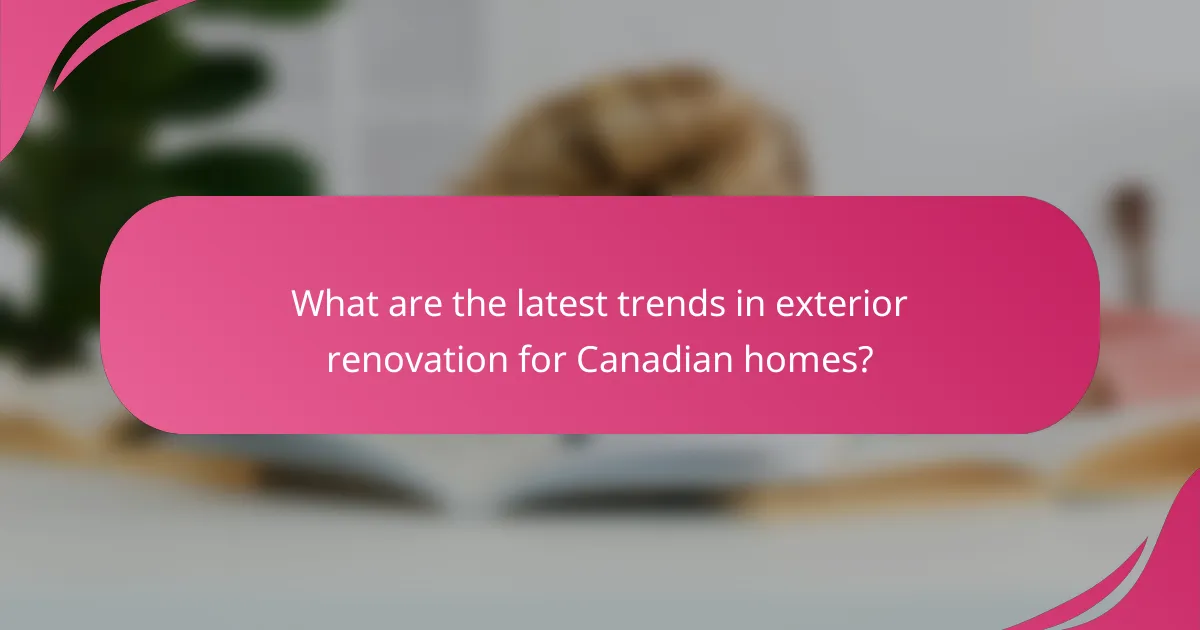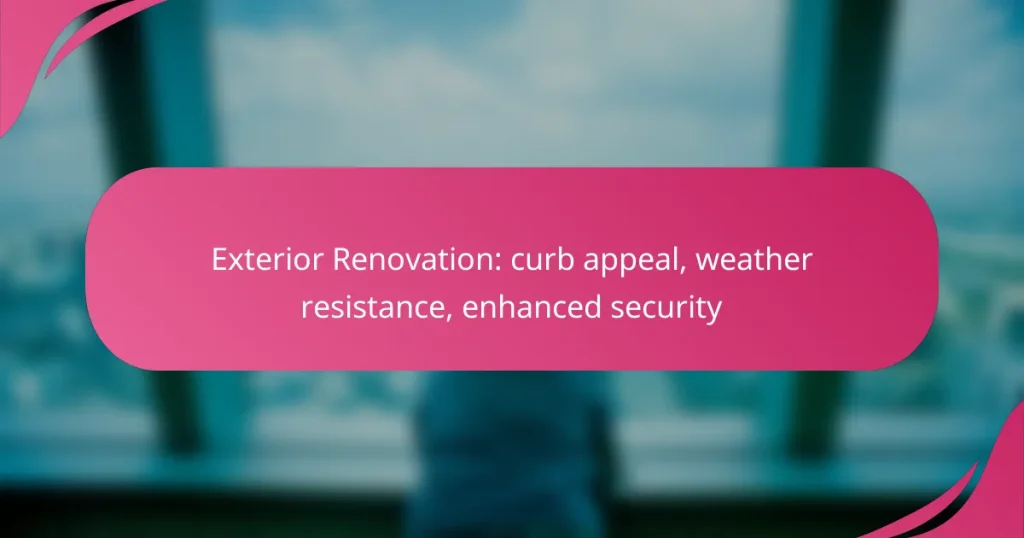Exterior renovation plays a crucial role in enhancing a home’s curb appeal, weather resistance, and security. By utilizing durable materials and modern design elements, homeowners can create an inviting atmosphere while ensuring their property withstands harsh Canadian climates. Additionally, upgrading vulnerable areas with advanced security features not only protects the home but also adds to its overall value and charm.

How can exterior renovation enhance curb appeal in Canada?
Exterior renovation can significantly enhance curb appeal in Canada by improving the aesthetic appeal and functionality of a property. This not only increases the value of the home but also creates a welcoming atmosphere that reflects the homeowner’s style.
Landscaping improvements
Effective landscaping can transform the exterior of a home, making it more inviting. Consider adding native plants, shrubs, and trees that thrive in the Canadian climate, which can reduce maintenance and water usage.
Incorporating features like flower beds, decorative stones, or mulch can enhance visual interest. Regular upkeep, such as mowing and pruning, ensures that the landscaping remains attractive year-round.
Fresh paint and siding
Applying fresh paint or updating siding can dramatically change the look of a home. Choose colors that complement the surroundings and adhere to local trends, which can appeal to potential buyers.
For siding, materials like vinyl or fiber cement are popular in Canada due to their durability and resistance to harsh weather. Ensure that any paint used is suitable for exterior conditions to prevent peeling and fading.
Upgraded entryways
Enhancing entryways can create a strong first impression. Consider replacing old doors with modern, energy-efficient options that provide better insulation and security.
Adding features like a new porch, railings, or decorative elements can make the entrance more inviting. Ensure that the pathway to the door is well-maintained and clear of obstructions.
Outdoor lighting solutions
Installing outdoor lighting can improve safety and highlight architectural features. Use LED fixtures for energy efficiency and longevity, and consider solar-powered options for easy installation.
Strategically placed lights along pathways, near entryways, and around landscaping can enhance visibility and create a warm ambiance. Ensure that lighting is not overly bright to maintain a cozy atmosphere while providing adequate illumination.

What materials improve weather resistance for homes in Canada?
In Canada, materials that enhance weather resistance for homes include vinyl siding, metal roofing, and composite decking. These materials are designed to withstand harsh climates, providing durability and protection against elements like snow, rain, and wind.
Vinyl siding
Vinyl siding is a popular choice for Canadian homes due to its excellent weather resistance and low maintenance requirements. It is available in various colors and styles, allowing homeowners to enhance curb appeal while ensuring protection against moisture and temperature fluctuations.
When selecting vinyl siding, look for products with a high R-value for insulation and UV resistance to prevent fading. Proper installation is crucial; ensure that it is securely fastened to withstand strong winds and heavy snowfall.
Metal roofing
Metal roofing is highly effective for weather resistance, especially in areas prone to heavy snowfall and rain. It offers superior durability, longevity, and reflects heat, which can help in reducing energy costs during hot summers.
Consider materials like steel or aluminum, which are lightweight yet strong. Ensure that the roofing system includes proper insulation and ventilation to prevent ice dam formation in winter months.
Composite decking
Composite decking is an excellent alternative to traditional wood decks, providing enhanced weather resistance and requiring minimal upkeep. It is made from a blend of wood fibers and recycled plastic, making it resistant to rot, splintering, and fading.
When choosing composite decking, look for products that are specifically designed for outdoor use and have a warranty against fading and staining. Proper installation is essential to ensure drainage and prevent water pooling, which can lead to damage over time.

How does exterior renovation enhance home security?
Exterior renovation can significantly boost home security by upgrading vulnerable areas and incorporating advanced protective features. Enhancements like impact-resistant windows, security doors, and smart home technology work together to deter break-ins and provide peace of mind.
Impact-resistant windows
Impact-resistant windows are designed to withstand strong forces, making them a formidable barrier against intruders. These windows typically feature laminated glass that remains intact even when struck, reducing the likelihood of break-ins. When selecting impact-resistant windows, consider options that meet local building codes and offer energy efficiency benefits.
Investing in these windows can also lower insurance premiums, as many insurers recognize their role in enhancing safety. Look for products that have been tested to meet standards such as ASTM E1886 and E1996 for optimal protection.
Security doors
Security doors provide an additional layer of protection at entry points, often constructed from heavy-duty materials like steel or reinforced fiberglass. These doors typically feature multi-point locking systems, which are more secure than standard locks. When choosing security doors, ensure they fit snugly within the frame to minimize vulnerabilities.
Consider doors that comply with local security standards and have features like peepholes or reinforced hinges. A well-installed security door can deter potential intruders and enhance the overall aesthetic of your home.
Smart home technology
Smart home technology enhances security by allowing homeowners to monitor and control their property remotely. Systems can include smart locks, security cameras, and motion sensors that send alerts to your smartphone. These devices can be integrated into a comprehensive security system for real-time surveillance and control.
When implementing smart technology, choose devices that are compatible with your existing home network and consider those with strong encryption to protect against hacking. Regularly update software and firmware to maintain security integrity.

What are the costs associated with exterior renovation in Canada?
Exterior renovation costs in Canada can vary significantly based on the scope of the project, materials used, and regional labor rates. Homeowners should expect to invest anywhere from a few thousand to tens of thousands of Canadian dollars, depending on their specific needs and preferences.
Average pricing for materials
The cost of materials for exterior renovations can range widely. For instance, siding materials like vinyl or wood can cost between CAD 2 to CAD 10 per square foot, while roofing materials may range from CAD 3 to CAD 15 per square foot. Choosing high-quality or specialized materials will increase costs but can enhance durability and aesthetics.
Other materials such as windows and doors typically range from CAD 300 to CAD 1,500 each, depending on size and energy efficiency ratings. It’s crucial to balance quality with budget to ensure long-lasting results.
Labor costs by region
Labor costs for exterior renovations in Canada can vary significantly by region. In urban areas like Toronto or Vancouver, hourly rates for skilled labor may range from CAD 50 to CAD 100, while rural areas might see rates closer to CAD 30 to CAD 60. This discrepancy can impact the overall cost of your renovation project.
Additionally, consider the complexity of the work. Specialized tasks, such as installing custom windows or intricate siding, may incur higher labor costs due to the expertise required.
Financing options
Homeowners in Canada have several financing options for exterior renovations. Many choose to use personal loans or home equity lines of credit (HELOC), which can offer lower interest rates compared to traditional loans. It’s advisable to compare rates from various lenders to find the best fit for your financial situation.
Additionally, some provinces offer grants or rebates for energy-efficient upgrades, which can help offset renovation costs. Researching local programs can provide significant savings while improving your home’s energy efficiency.

What factors should be considered before starting an exterior renovation?
Before beginning an exterior renovation, it’s essential to evaluate local building codes, neighborhood aesthetics, and climate considerations. These factors will guide your decisions, ensuring compliance, visual harmony, and durability in your renovation project.
Local building codes
Local building codes dictate what is permissible in your area regarding construction and renovation. These regulations can cover everything from structural integrity to aesthetic guidelines, and failing to comply can result in fines or required modifications.
Check with your local municipality for specific codes that may apply to your project. This may include permits for structural changes, electrical work, or plumbing updates, which can add to your overall renovation timeline and budget.
Neighborhood aesthetics
Considering neighborhood aesthetics is crucial for maintaining property values and ensuring your renovation complements surrounding homes. A well-planned exterior renovation should reflect the architectural style and character of the neighborhood.
Observe the colors, materials, and landscaping of nearby properties. Aim for a cohesive look by selecting elements that harmonize with your neighbors while still allowing for personal expression. This balance can enhance curb appeal and foster community acceptance.
Climate considerations
Climate plays a significant role in determining the materials and design elements suitable for your exterior renovation. Different weather conditions can affect the durability and maintenance needs of various materials.
For instance, in regions with heavy rainfall, consider using water-resistant materials and proper drainage systems. In areas with extreme temperatures, energy-efficient windows and insulation can help regulate indoor climate and reduce energy costs. Always choose materials that withstand local weather patterns to ensure longevity and performance.

What are the latest trends in exterior renovation for Canadian homes?
Recent trends in exterior renovation for Canadian homes focus on enhancing curb appeal, improving weather resistance, and boosting security. Homeowners are increasingly opting for sustainable materials and innovative designs that not only elevate aesthetics but also provide long-term durability and safety.
Sustainable materials
Sustainable materials are becoming a popular choice in exterior renovations, as they offer environmental benefits alongside aesthetic appeal. Options such as reclaimed wood, fiber-cement siding, and recycled metal roofing are gaining traction among homeowners looking to reduce their carbon footprint.
When selecting sustainable materials, consider their longevity and maintenance requirements. For instance, fiber-cement siding is known for its durability and resistance to harsh weather, making it a practical choice for Canadian climates. Additionally, using locally sourced materials can further minimize environmental impact and support local economies.
Be cautious of the initial costs associated with sustainable materials, as they can be higher than traditional options. However, the long-term savings on energy bills and maintenance can offset these upfront expenses. Always check for certifications like LEED or Energy Star to ensure the materials meet sustainability standards.


